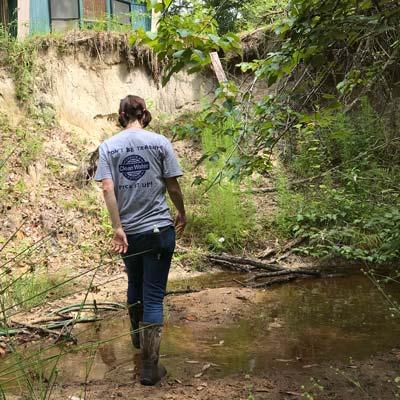Grant Awarded for Fish River Watershed Stream Restorations by NFWF Gulf Environmental Benefit Fund
The Mobile Bay National Estuary receives award from NFWF Gulf Environmental Benefit Fund to restore conditions in and around Lower Fish River Watershed streams

Extensive Erosion at Marlow Branch Tributary | Photo by Geosyntec
On March 19, 2020, the National Fish and Wildlife Foundation (NFWF) announced new Alabama projects to be funded by the Gulf Environmental Benefit Fund (GEBF) and designed to remedy harm and reduce risk of future harm to natural resources affected by the 2010 Deepwater Horizon oil spill. The Mobile Bay National Estuary Program (MBNEP) will receive more than $6.54 million to address sediment and nutrient issues in the Lower Fish River Watershed, one of a complex of four coastal watersheds draining into Weeks Bay. Project activities will include planning, engineering and design, and permitting efforts to identify and develop solutions for six stormwater-impacted tributaries. The award will also fund engineering and design, permitting, and construction of a 1,650-linear-foot priority stream restoration project in the Marlow Community. This tributary runs south of and parallel to Baldwin County Road 32, passes under CR 9 near its intersection with CR 32, and drains into Fish River just downstream of the Fish River Bridge on CR 32. These issues were identified and restoration measures recommended in the Weeks Bay Watershed Management Plan, published in 2017 and funded through the NFWF GEBF.
Multiple tributaries within the Lower Fish River Watershed have been negatively impacted by severe erosion and nutrient enrichment in headwater areas, delivering silt and negatively impacting once-productive downstream seagrass beds and oyster reef habitats essential to coastal fishery health. Restoring and protecting priority streams and streambank corridors is vital to improving the overall water quality in this Watershed and its receiving waters in Weeks Bay. The overall project strategy will employ similar hybrid stream restoration techniques as those used to restore over two miles of degraded streams and 44 acres of floodplain and wetlands in the successful GEBF-funded D’Olive Watershed restoration project.
The MBNEP is guided by a Comprehensive Conservation and Management Plan developed by over 200 Management Conference partners from federal, state, and local partners; businesses and industry; academia and citizen groups. It is based on local input and supports local priorities that protect water quality, sustain populations of key living resources, manage vital habitats, mitigate human impacts, and build citizen stewardship. The CCMP provides a road map for estuarine resource management in Alabama through a watershed approach that prescribes watershed management planning for areas draining to specific water bodies – independent of geopolitical boundaries. This approach ensures restoration and protection projects are based in science and fit into a well-studied and structured overall management program.
The mission of the Mobile Bay National Estuary Program is to provide the necessary tools and support community-based efforts to promote the wise stewardship of the quality and living resources of Alabama’s estuarine waters.
Lower Fish River Watershed




